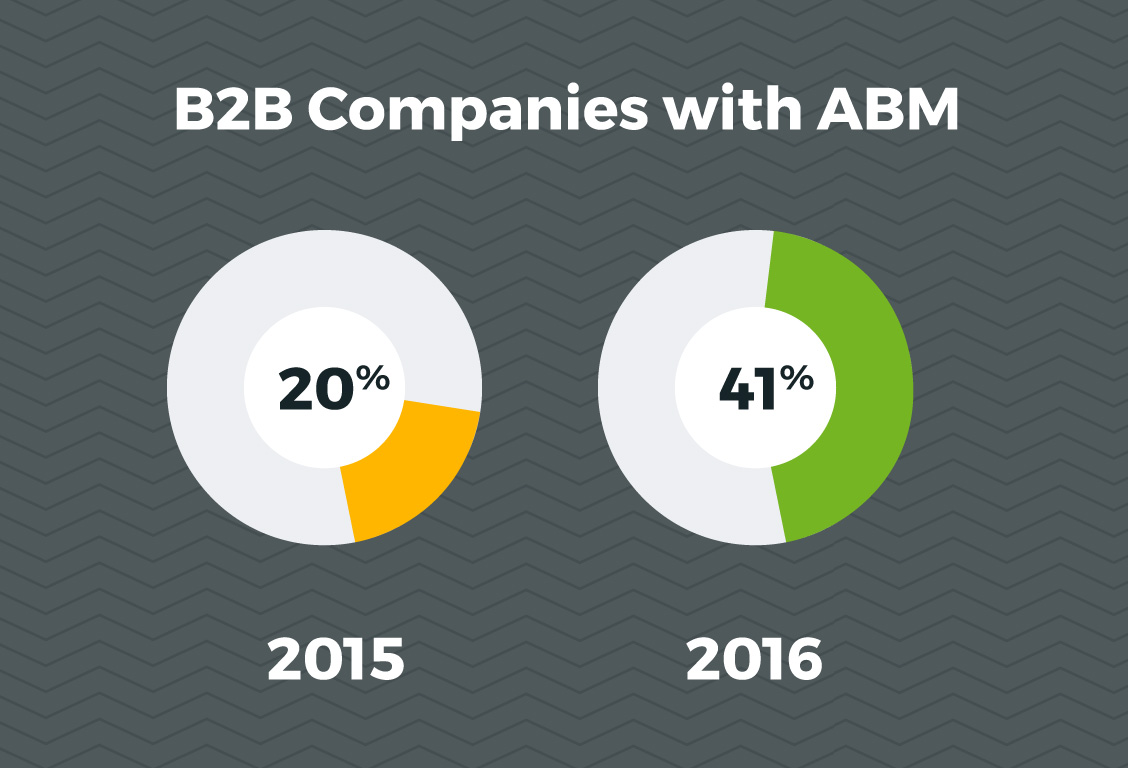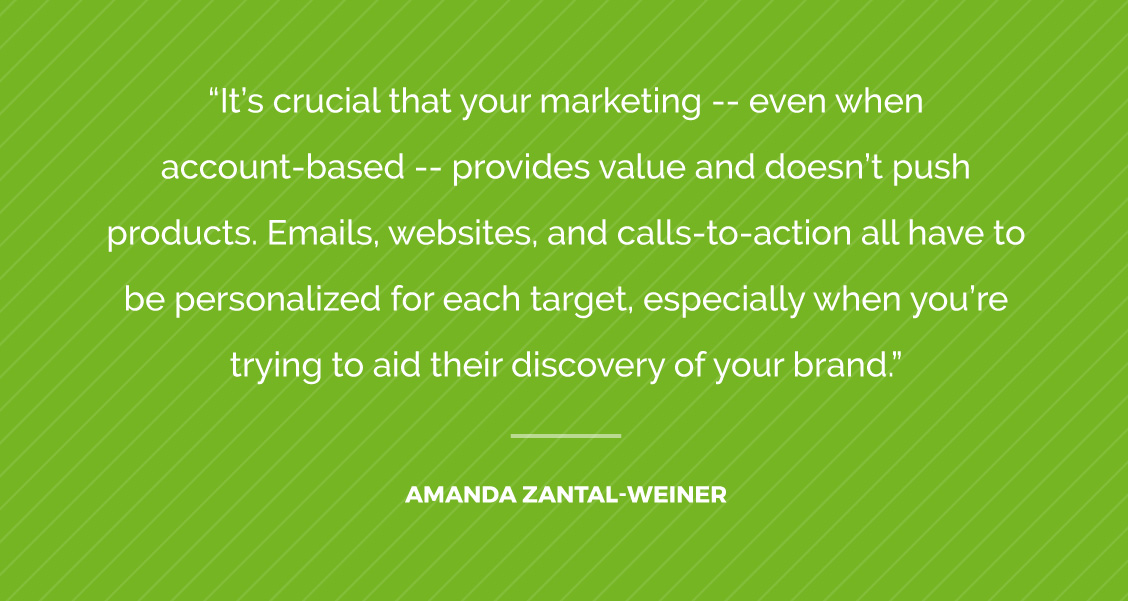 Account-based marketing (ABM) is the new kid on the block in the world of business-to-business sales. In a Forbes.com interview, Jon Miller, Engagio founder and former CMO of Marketo, posits that the technology and essentials for effective, scalable ABM have really only been around for a few years, although the basic principles have been in existence for much longer. Fortunately, huge leaps in martech, data management and audience targeting tools, in particular, are making account-based marketing much more attainable. If your company isn’t using these strategies yet, this is your year to begin.
Account-based marketing (ABM) is the new kid on the block in the world of business-to-business sales. In a Forbes.com interview, Jon Miller, Engagio founder and former CMO of Marketo, posits that the technology and essentials for effective, scalable ABM have really only been around for a few years, although the basic principles have been in existence for much longer. Fortunately, huge leaps in martech, data management and audience targeting tools, in particular, are making account-based marketing much more attainable. If your company isn’t using these strategies yet, this is your year to begin.
Over 40% of B2B Marketers Already Using ABM
 A State of Account-Based Marketing Survey, conducted by Sirius Decisions in 2015, reveals that over 90 percent of marketers understand how crucial account-based marketing is. They see the results in other companies — larger deals with coveted accounts, a swifter revenue pipeline, and improved sales alignment. In 2015, only 20 percent of the B2B companies surveyed had an ABM program in place; but according to another SiriusDecisions survey in 2016, adoption of ABM strategies increased dramatically in just one year. In April 2016, when the second survey’s findings were released, 41 percent of B2B companies had a full ABM program in place, while another 58 percent were testing ABM strategies.
A State of Account-Based Marketing Survey, conducted by Sirius Decisions in 2015, reveals that over 90 percent of marketers understand how crucial account-based marketing is. They see the results in other companies — larger deals with coveted accounts, a swifter revenue pipeline, and improved sales alignment. In 2015, only 20 percent of the B2B companies surveyed had an ABM program in place; but according to another SiriusDecisions survey in 2016, adoption of ABM strategies increased dramatically in just one year. In April 2016, when the second survey’s findings were released, 41 percent of B2B companies had a full ABM program in place, while another 58 percent were testing ABM strategies.
A New Perspective
Account-based marketing works best for companies with a business-to-business sales model. It’s a way of looking at a specific account or potential account and treating it like a specialized target market. In the same way that some companies focus on groups of people as their target audience of potential customers, B2B companies using ABM will identify valuable accounts and market directly to those accounts, creating a customized sales strategy just for that desirable client.
Leveraging Martech to Identify the Power Players
When you’re using ABM, it’s all about identifying the movers and shakers within the company you’re trying to win over. You’re looking at the various departments within that target company to identify your power players: noting the decision-makers and the people who can exert the pressure from within their company to buy your products or services.
Identifying these power players is a key function of the martech tools you already have. Whether you’re using an email automation provider as simple as MailChimp, or something more robust such as HubSpot or Marketo, you should be able to look into your database and export a list of all your email recipients. From there, you can put them into a pivot table in MS Excel to see which titles are recurring most often. That list of most frequently used titles can give you a great start in identifying who your power players are.
If you’re using Marketo, which has the AdBridge functionality, you can even send your targeted lists over to the advertising platforms (such as Facebook and LinkedIn) directly.
A Soft Sell
No one enjoys the feeling of being pressured into purchasing something, so businesses have to be very careful and intentional in their ABM strategies. In her HubSpot.com article “The Ultimate Guide to Account-Based Marketing: 6 Key Steps,” Amanda Zantal-Weiner says, “It’s crucial that your marketing — even when account-based — provides value and doesn’t push products. Emails, websites, and calls-to-action all have to be personalized for each target, especially when you’re trying to aid their discovery of your brand.”

While Amanda was focused mainly on digital marketing channels with her comment, it’s important to remember that old school marketing channels, such as direct mail and catalogs, can be personalized to help create a meaningful touchpoint in the ABM prospecting lifecycle.
A Team Effort
In the past, the typical marketing team prepped the strategy, the ads, and the other marketing materials, and the sales team used those tools to sell product, whether to individuals or to other businesses. The two efforts were related, but often companies did not see a strong connection between those departments.
According to an article for CIO.com, written by content marketing consultant and blogger James A. Martin, ABM is bringing the different departments of sales and marketing much closer together. As you implement ABM for your business, you’ll find that collaboration increases as your entire marketing and sales strategy narrows its focus. Your teams will be working together, giving all their energy to acquiring coveted, qualified leads and retaining those key clients.
In relation to martech, this means your marketing and sales tools need, more than ever, to talk closely to each other. If you’re using SalesForce as your CRM, you’re in good shape, as most major marketing solutions integrate closely with SalesForce. If you’re using an industry niche CRM, or one not so widely used as SalesForce, then you should evaluate whether your marketing tools can talk to your CRM through Zapier.
Tools of the Trade for ABM
In order to effectively implement ABM for your business-to-business connections, you’re going to need some helpful tools. According to G2Crowd.com, some of the top account-based execution products are Terminus, Azalead, DemandBase, and Sendbloom. For account-based reporting, you can use products such as Engagio, Infer, Bizible, Marketo, LeanData, or Terminus.
Writing for TechnologyAdvice.com, marketing tech expert Tamara Scott offers a brief overview of the most interesting and effective ABM tools. Marketo is best known as a top marketing automation platform, but it currently includes a broad selection of valuable ABM tools as well. The only downside is that these ABM tools inside of Marketo are considered add-ons, and so you’ll need to free up additional marketing budget.
As a predictive marketing program, Infer is useful for drawing all your internal data together and helping you see which high-value clients you should target. As for Engagio, it’s a smart business solution that has been designed for ABM, and it includes campaign analytics, account tracking, and lead matching. Thanks to the Playmaker feature, Engagio has recently become even more useful for companies pursuing ABM. Of course, there is also Terminus, a magnificent tool with a vast database. It’s a powerhouse that allows you to develop targeted campaigns within a short time.
The Net vs. the Spear
With the proven market power of ABM and these tools at your fingertips, there’s no reason not to apply this style of marketing to your B2B strategy. Engagio CEO Jon Miller explains it best with an apt analogy: When you use traditional marketing, you’re fishing with a net. You may catch some great fish, but you’ll also end up with some that aren’t a good match. You’re spending time and resources, but your efforts are not focused, so some of those resources are wasted. In contrast, account-based marketing is laser-focused — fishing with a spear so that you get precisely the kind of fish you want.
Start the ABM ball rolling in your organization today. One of the best ways to get a better grasp of how ABM can help your organization, and how it fits into your overall martech strategy, is to ask ABM solution providers to demo their wares. You should also arrange some meetings with your sales team and marketing group so you can discuss your current clients and future prospects, along with some strategies for getting that laser focus. Implementing ABM may feel like a big task, but once you’ve run several high-value target buyer organizations through your ABM, you’ll see the immense value it will bring to your company.



